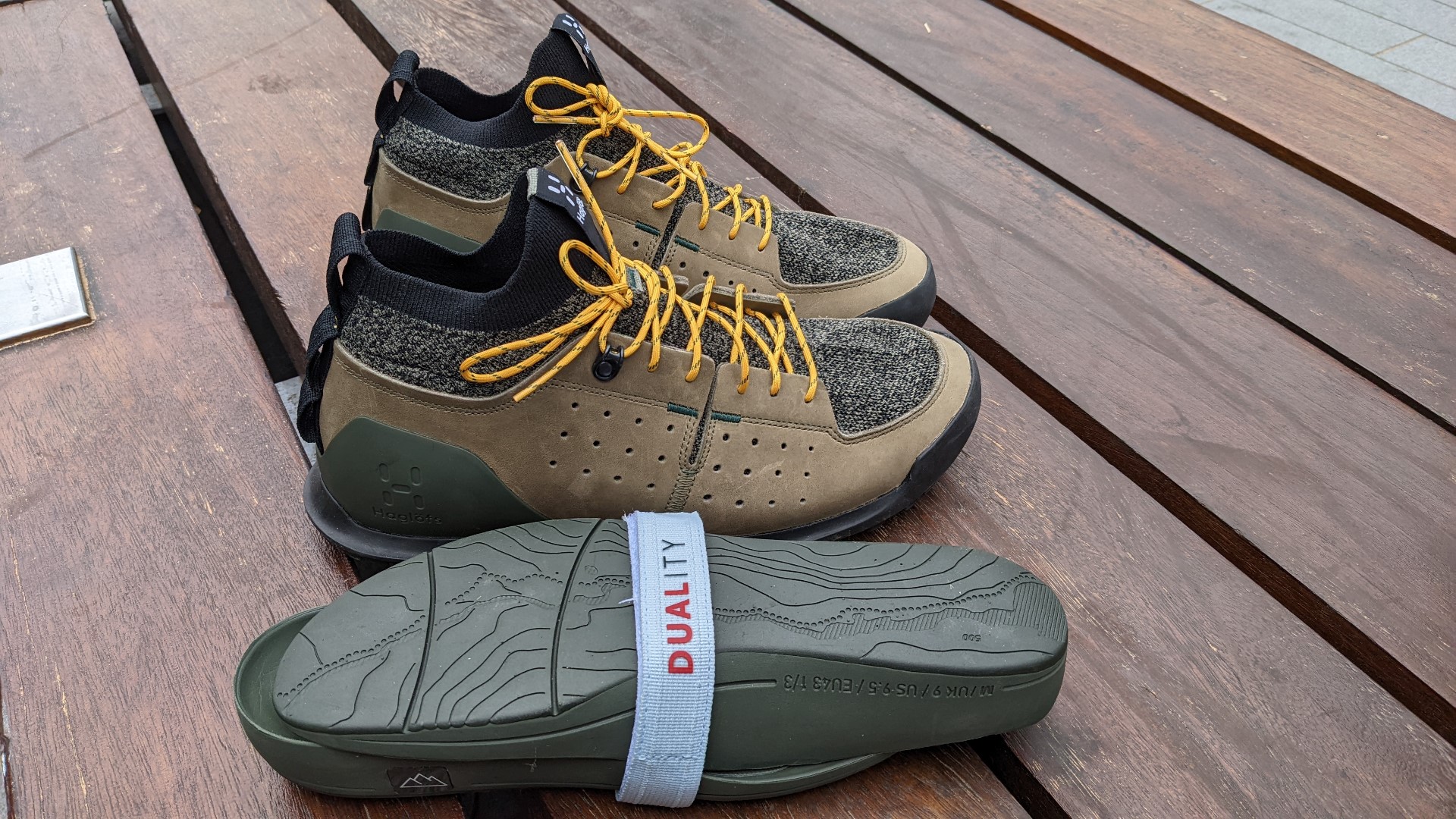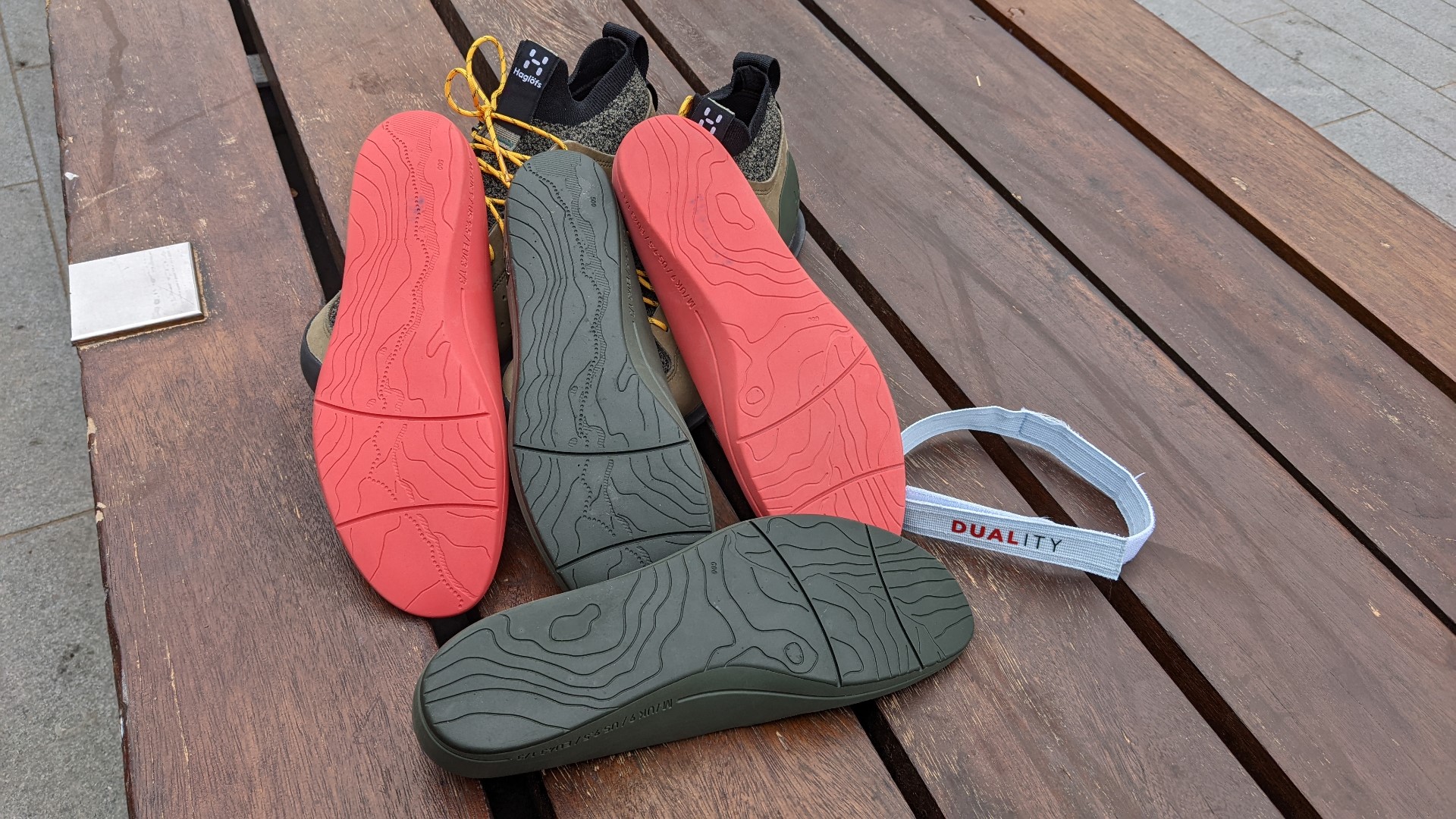These Haglofs hiking boots transform into city shoes – I tried them on a weekend break
Here's my verdict on the swappable-soled Haglofs Duality AT2 boots


The Haglofs Duality AT2 shoe is – at first sight – a relatively standard if slightly left-field design outdoor shoe. There's a knitted tongue-area and internal sock-style upper, nubuck reinforcement around the toe, sides and rear, with a stiff TPU heel and a soft rubber sole. The design uses the sock as a tongue, but aside from the bright yellow laces, is otherwise unlikely to get many glances in the street or trail alike.
This boot is from the same line as the AT1 that appears in our best men's hiking boot guide, and like that boot, it's designed for extra versatility. The trickery really begins under the skin, and is where the 'duality' in the name comes in. The hidden trick of the Haglofs Duality AT2 is that it comes with two sets of insole-midsoles that enable you to take on different terrain in the same shoes. A softer red pair is intended for city streets and hard surfaces, the stiffer, harder compound greeny-black pair for more punishing pursuits and rocky trails. I took them on city breaks in Brighton and London to test them out.

The first thing you’ll notice when slipping the Haglofs Duality AT2 on is that sock-like fit, which makes the initial experience feel very slipper-like. This makes for a super-comfort fit around town, especially with the softer red sole unit in place. The thing you probably won't notice is the strong environmental undertow of these shoes. That sock is 100% recycled polyester, the leather from a tannery audited by the Leather Working Group, and the DWR-treatment is fluorocarbon free. In addition, the webbing and laces are made from 100% recycled polyester, and the titular midsoles incorporate algae-based Bloom Foam, which cuts down on petroleum-based products, as well as reduces water use and co2 creation.
The soles are also unusual in that they’re essentially very large insoles, the midsole being bonded to the insole to create a single unit, making them convenient to swap around in almost any situation. Haglofs suggests you might want to try this mid-trail, which feels a touch too much, but would be possible.
The weird thing about this arrangement is that almost all the shoe’s rigidity is in the insole units. Without one fitted, there’s nothing but rubber outsole to stiffen the shoe, rather like a wellington boot. The retail box comes with a robust velcro band, which lets you lash the spare pair of insoles together neatly, which when packing light is much appreciated.

Strolling to the train station shod in the Haglofs Duality AT2 with the softer red sole unit, there’s very little to complain about. That slipper-softness extends to the density sole too, creating a pleasant footfeel, and there’s plenty of energy return in even the lighter-grade insole. Rambling around town it’s also apparent that the outsole isn’t just flexible, it's made from two different grades of rubber invisibly linked together. The forefoot is an incredibly grippy, soft compound that feels almost like a climbing shoe, while the heel is apparently made from AHAR Plus (ASICS High Abrasion Resistance Rubber), a much harder compound. This is fortunate, as the midfoot compound feels too soft to last long, fun as it is to wear.
There’s an interesting problem in that the combination of a very soft boot and combining the insole and midsole into a stiffer unit means that it’s quite easy to roll the foot off the moulded insole, finding the sharp, shaped edge of the sole. Weirdly, it’s more of an issue around town with lightly-laced shoes, as opposed to the trail with tighter, more aggressive lacing.
Get all the latest news, reviews, deals and buying guides on gorgeous tech, home and active products from the T3 experts
Indeed, a ramble up a nearby South Downs hillside soon makes very clear the difference between the two insoles too. The green trail rated ones are considerably stiffer, completely changing the performance of the shoe. Looking closely at the two insoles, the green has a hard layer covering the sole, extra support and protection from trail-based rocks or pebbles, both very welcome on the South Coast tracks and trails. A nice little detail is that the underside of the soles are patterned with contour lines – in the case of the stiffer green versions, hillside contours, in the case of the red a marked footpath.
So are the Haglofs Duality AT2 good at city breaks with an active edge? Absolutely, yes. We’d recommend testing the fit before leaving, to avoid any issues with the edges of the insoles, and it’s worth bearing in mind that there’s no waterproof membrane here. So while that gives a breathable and comfy shoe around town, rambling through wet grass and puddles will lead to damp toes and discomfort. However, the chance to pack two shoes into one can’t be underestimated, especially for European getaways among bigger hills.
The Haglofs Duality AT2 boots are available in men's and women's versions, at an RRP of £200.

Mark Mayne has been covering tech, gadgets and outdoor innovation for longer than he can remember. A keen climber, mountaineer and scuba diver, he is also a dedicated weather enthusiast and flapjack consumption expert.